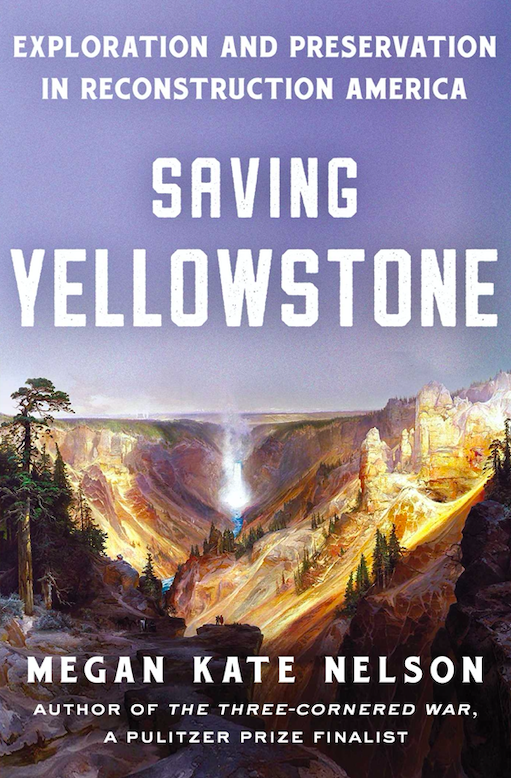REVIEW: ‘Saving Yellowstone: Exploration and Preservation in Reconstruction America’
Photo courtesy of Sharona Jacobs / Provided by Scribner.
Megan Kate Nelson’s new book, Saving Yellowstone: Exploration and Preservation in Reconstruction America, is a fascinating examination of the expedition led by Ferdinand Hayden into the area that would become Yellowstone National Park. The setting is the summer of 1871, a tumultuous time in American history, with the country still reeling from the effects of the Civil War and Ulysses S. Grant in the White House. This was also a time period of expansion across the West and the loss of land and rights of many Native American tribes.
Nelson decides to broaden the focus beyond Hayden, which is a smart move. She also includes Sitting Bull, a Lakota leader who becomes a central figure in the conflicts occurring near the Yellowstone River, the tributary that gave the park its name, and Jay Cooke, who puts his company’s wealth on the line to build a railroad that would allow East Coast residents the chance to vacation in this land of unmatched splendor.
Along the way, the author also details the Grant presidency, showcasing the administration’s Reconstruction-era policies, including taking on the Ku Klux Klan in the South. She draws a comparison between these policies that attempted to protect the rights of recently enslaved people and the destruction of cultures and communities in the West, at almost the same time. The takeaway is that the 1870s were a turning point in American history, with deep divisions becoming apparent and bloodshed still on the horizon.
The glue that keeps everyone and everything in the book together is this natural wonder called Yellowstone (often referred to as the Yellowstone Basin). There’s a thrill when Hayden and his expedition team make their way through Gardiner, Montana, and find the geological feature that would later be christened Mammoth Hot Springs. There are also scenes that take place around the geysers and “the lake,” which is Yellowstone Lake. One section takes the expedition team to the top of Mount Washburn, and another chapter takes them to the rim and depths of the Grand Canyon of the Yellowstone. Accompanying Hayden are scientists and researchers, some with minimal credentials, plus a photographer and artist (Thomas Moran) — all employed to capture the story of this unique place and bring back the narrative for East Coast legislators and hopeful vacationers.
Nelson includes a line from Martin J.S. Rudwick that could be a thesis for her entire book: “There is nothing like standing on a mountaintop for seeing how everything fits together.”
The relatively quick read (fewer than 200 pages of content, plus nearly 130 pages of notes and a bibliography) goes into depth about the expedition and then reserves some chapters for Sitting Bull, Cooke and Grant’s policies toward the South and West. Saving Yellowstone is not an exhaustive look at the founding of Yellowstone National Park or the United States in the 1870s, but it gets the job done with Hayden and his contemporaries as central characters.
One side point: Parallels to today’s society and the ongoing discussions about Hayden are mostly absent from the book. Hayden’s name, for example, has been used to label a wondrously beautiful valley not far from the Grand Canyon in Yellowstone. This has led to an honest debate about the appropriateness of having a “Hayden Valley,” given his indefensible views of Native Americans. Advocates are pushing for Hayden Valley to be called Buffalo Nations Valley.
Also missing — and perhaps this is because the subject was not brought up to a large extent in Hayden’s reportage — are the so-called charismatic megafauna of Yellowstone, including wolves and bears. There is mention of antelope (pronghorn) and bison for the food they provided and the hunting strategies employed, but this is more of a people’s history of Yellowstone, with interludes about geysers, rivers and geology. That’s actually a refreshing omission because the Yellowstone library of books — and there are many of them — are almost exclusively about wolves and bears, a fascinating topic to be sure, but the literature needs to include more than the “charismatic” offerings. Nelson, to her credit, fills in blanks on the Yellowstone story with real people, human heartbreak, distressing tragedy.
Nelson is skilled at moving the narrative along and showcasing the energy of travel, the behind-the-scenes action of mounting an expedition, the interconnected threads of history and how individual people were impacted by the historical events of the day. She offers many pages to the voices of those impacted by slavery and discrimination in the American South, and the mistreatment of Indigenous tribes of the Great Plains and beyond. She finds the hypocrisy in the policies of the day, examining how legislative sessions and decisions in Washington, D.C., had reverberations across the country and across communities.
Of course, all things begin and start with Yellowstone, this jewel of a preserved land. As the title suggests, amidst the tumult, there is this remarkable story of preservation and “saving.” It’s no coincidence that Saving Yellowstone was published this year: March 1, 2022, was Yellowstone’s 150th birthday. The national park is perpetually in the news, and the debates and discussions that were present in the 1870s continue to this day.
By John Soltes / Publisher / John@HollywoodSoapbox.com
Saving Yellowstone: Exploration and Preservation in Reconstruction America by Megan Kate Nelson. 320 pages. Scribner. Click here for more information.


